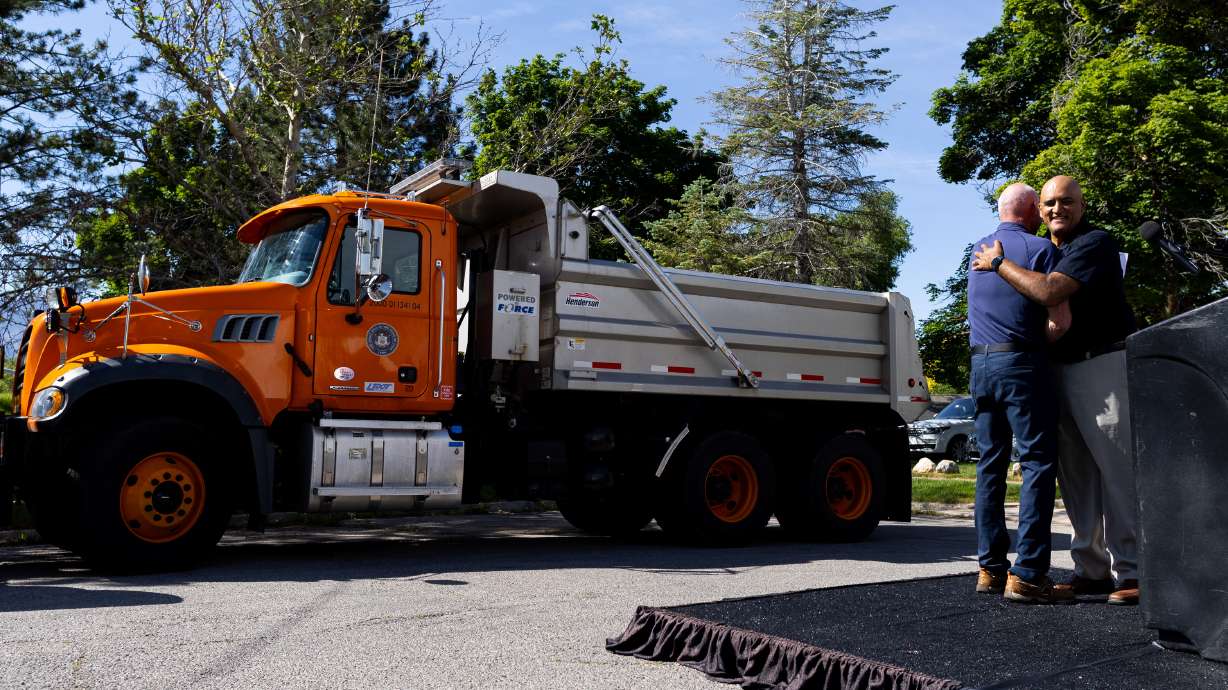Estimated read time: 4-5 minutes
This archived news story is available only for your personal, non-commercial use. Information in the story may be outdated or superseded by additional information. Reading or replaying the story in its archived form does not constitute a republication of the story.
SALT LAKE CITY — Shailen Bhatt and Carlos Braceras hopped into a golf cart Thursday and barreled toward a red light on Foothill Drive when the light switched to green just before they entered the crosswalk.
What all the drivers around them don't know is that Bhatt, the U.S. federal highway administrator, and Braceras, executive director of the Utah Department of Transportation, had a device packed in a briefcase behind them sending a signal to the box running the traffic light operations. The device, using vehicle-to-everything technology, told the light to change the signal in their favor as they approached the intersection.
The Utah Department of Transportation has already implemented this technology on many state snowplows and Utah Transit Authority vehicles to enhance road clearance times and keep buses on schedule. However, it's about to expand its capabilities, along with two neighboring states, through a $20 million federal grant awarded to Utah.
The Federal Highway Administration announced the grant on Thursday, which represents one-third of the $60 million it is sending to a few states to expand vehicle-to-everything — otherwise known as V2X — technology. A part of the money UDOT received will go toward helping Colorado and Wyoming implement a similar system as a part of its goal to "connect the West."
"This is kind of a big deal," Braceras said. "We're at this point where technology is merging with transportation like never before and I think we're seeing this big change right now."
How V2X is used today
Utah is one of the leaders in V2X technology. UDOT started experimenting with it after partnering with Panasonic's North American arm. It exists in about 20% of the Salt Lake City metro area, as well as in other parts of the state.
Vehicles equipped with V2X currently use it to improve route efficiency. For instance, a UDOT snowplow can automatically get a green light to clear roads faster. Some UTA buses have this behind the seat of a driver to either keep a green light running longer or shorten a red light when it detects the bus is running enough behind schedule, thus helping the driver — unaware there's a device even doing this — catch back up.
"(We're) one of the first transit authorities in the country using this technology," says UTA director Jay Fox.

The new funding will help get the Salt Lake metropolitan area up to at least 25%, hitting the current federal goal for major metro areas. The Federal Highway Administration is trying to implement V2X in at least 25% of all intersections within the 75 largest metro areas in the nation.
That's just the beginning. Fox said V2X is installed on 87 of UTA's vehicles, but his goal is to have it on the agency's entire fleet by the decade's end. UDOT officials add that since nearly all Utah signals are connected to fiber optic cables, its program could be expanded almost everywhere in the state.
The grant will also help UDOT create a "seamless and reliable" network between it, Colorado and Wyoming. Braceras explained that the neighbor states will oversee how their system is constructed, but UDOT will oversee how all of the money is spent between the three states and offer consultation.
The rest of the federal funding announced Thursday will go toward V2X implementations in Arizona and Texas. All of the funds come from the Bipartisan Infrastructure Law passed in 2021.
The future of V2X
Its expansion could help improve transit and snowplow efficiency today, but federal and state experts envision a future where this type of technology improves roadway safety.
Bhatt says it can be used to help warn drivers when there's danger around — such as crashes, wrong-way drivers, pedestrians or bicyclists approaching intersections, or vehicles stopped around blind corners. Some similar technologies already exist in personal vehicles but it's not a standard feature.
"That's the future we want to get to; we're just not there yet," Bhatt said.
This could help reduce the number of roadway fatalities across the U.S., a tally that reached nearly 41,000 last year.

Salt Lake City Mayor Erin Mendenhall, who announced a citywide initiative to cut down on traffic deaths in Utah's capital city last year, said V2X could be a game-changer toward the city's goals.
"It's a way of thinking about technology that we hadn't even contemplated, I think, just a matter of a few years ago," she said. "It's a huge advantage for the state of Utah."
Braceras agreed.
He pointed to the number of deaths that drastically dropped after seat belts were standardized and brakes were improved. He believes technology like V2X can have the same kind of "significant impact."
"We're going to save lives and make lives much better," he said.










